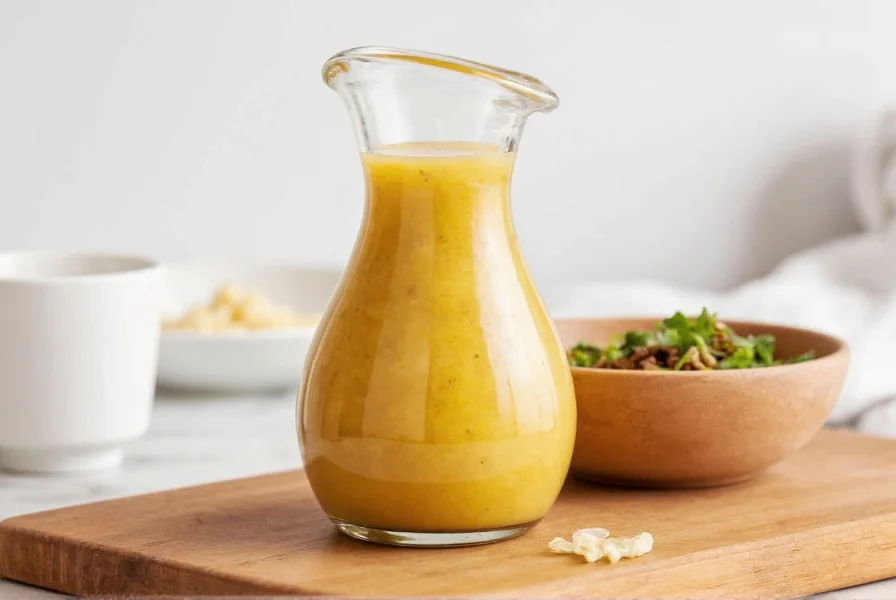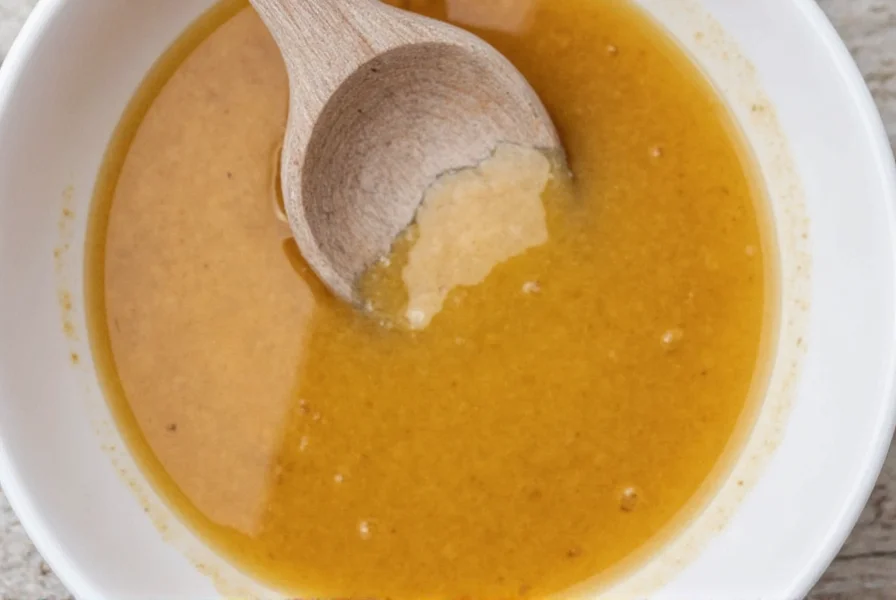Miso ginger dressing has become a staple in modern healthy kitchens for good reason. This simple yet sophisticated sauce brings together the deep umami of fermented soybeans with the bright, spicy notes of fresh ginger to create a dressing that elevates ordinary ingredients into extraordinary meals. Unlike store-bought versions that often contain added sugars and preservatives, homemade miso ginger dressing lets you control the quality and balance of ingredients while maximizing nutritional benefits.
The Essential Components of Authentic Miso Ginger Dressing
Understanding each ingredient's role helps you create the perfect dressing every time. The magic happens when these elements work in harmony:
| Ingredient | Function | Recommended Type |
|---|---|---|
| Miso Paste | Provides umami depth and saltiness | White (shiro) or yellow miso for milder flavor |
| Fresh Ginger | Delivers bright, spicy notes | Young ginger, finely grated |
| Rice Vinegar | Offers acidity to balance richness | Unseasoned rice vinegar |
| Neutral Oil | Creates emulsion and smooth texture | Avocado or grapeseed oil |
| Sesame Oil | Adds nutty aroma (use sparingly) | Toasted sesame oil |
Perfect Homemade Miso Ginger Dressing Recipe
This chef-tested recipe yields approximately 1 cup of dressing with balanced flavors that work across multiple applications. The key to exceptional miso ginger dressing lies in ingredient quality and proper emulsification.
Ingredients
- ¼ cup white miso paste (shiro miso)
- 2 tablespoons rice vinegar
- 3 tablespoons neutral oil (avocado or grapeseed)
- 1 tablespoon toasted sesame oil
- 1½ tablespoons freshly grated ginger
- 1 tablespoon pure maple syrup or honey
- 1-2 tablespoons water (for desired consistency)
- 1 small garlic clove, minced (optional)
Step-by-Step Preparation
- Whisk miso paste with rice vinegar in a small bowl until completely smooth and no lumps remain
- Gradually add neutral oil while continuously whisking to create an emulsion
- Incorporate sesame oil, freshly grated ginger, and sweetener
- Add water one tablespoon at a time until reaching your preferred consistency
- Taste and adjust balance: more vinegar for acidity, more miso for umami, or more sweetener if too salty
- Transfer to an airtight container and refrigerate for at least 30 minutes before serving

Why This Flavor Combination Works So Well
The brilliance of miso ginger dressing lies in its perfect balance of fundamental taste elements. Miso contributes deep umami and saltiness from fermentation, while fresh ginger provides bright, spicy top notes that cut through the richness. Rice vinegar adds necessary acidity to balance the fat content from oils, creating a dressing that feels light despite its rich ingredients.
When properly emulsified, the dressing coats ingredients evenly without separating. The enzymatic action of fresh ginger actually helps break down some compounds in the miso, creating more complex flavor compounds as it sits. This is why letting your dressing rest for at least 30 minutes before use significantly improves the final taste.
Best Applications for Miso Ginger Dressing
While excellent as a salad dressing, this versatile sauce shines in multiple culinary applications. Understanding which dishes benefit most from its unique flavor profile helps maximize your cooking efficiency.
Ideal Salad Combinations
- Simple Green Salad: Mixed greens, cucumber, radish, and toasted almonds
- Asian Slaw: Shredded cabbage, carrots, red bell pepper, and scallions
- Grain Bowl Base: Quinoa or brown rice with roasted sweet potatoes and edamame
- Protein-Enhanced: Grilled salmon or tofu with avocado and sprouts
Creative Uses Beyond Salad
- Marinade for salmon, chicken, or tofu (use 30 minutes to 2 hours)
- Dipping sauce for spring rolls or dumplings
- Drizzle over roasted vegetables like broccoli or Brussels sprouts
- Base for cold noodle dishes (thin with additional water or vinegar)
- Spread for sushi rolls or rice bowls
Storage Guidelines and Shelf Life
Proper storage maintains both safety and optimal flavor. Homemade miso ginger dressing lacks the preservatives found in commercial versions, so understanding its shelf life is crucial.
| Storage Method | Refrigerated | Freezer |
|---|---|---|
| Airtight Container | 7-10 days | 1-2 months (thaw in refrigerator) |
| With Raw Garlic | 5-7 days | Not recommended |
| Signs of Spoilage | Mold, sour smell, separation that doesn't remix | Ice crystals, off flavors after thawing |
Always use a clean spoon when serving to prevent contamination. If separation occurs (normal with oil-based dressings), simply whisk or shake vigorously before use. The dressing may thicken when refrigerated—add water one teaspoon at a time to restore desired consistency.
Common Variations for Dietary Needs
Adapting miso ginger dressing for different dietary requirements is straightforward while maintaining excellent flavor:
- Gluten-Free: Ensure your miso paste is certified gluten-free (most white miso is naturally GF)
- Vegan: Substitute honey with maple syrup or date syrup
- Lower Sodium: Use ⅓ cup miso instead of ¼ cup and add 1 tablespoon extra water
- Spicier Version: Add ½ teaspoon sriracha or ¼ teaspoon red pepper flakes
- Creamier Texture: Blend in 1 tablespoon tahini or Greek yogurt
Troubleshooting Common Issues
Even simple dressings can present challenges. Here's how to address common problems:
- Too Salty: Balance with additional sweetener and acid (vinegar or citrus juice)
- Too Thick: Add water or additional vinegar one teaspoon at a time
- Separation: Proper emulsification prevents this—whisk vigorously or use a small blender
- Bland Flavor: Increase ginger quantity or add a pinch of citrus zest for brightness
- Overpowering Ginger: Let sit for 24 hours—the flavor will mellow as it marinates
Frequently Asked Questions
Can I use red miso instead of white miso for dressing?
Yes, but red miso (akaaka miso) has a stronger, saltier flavor that works better in heartier applications. For salad dressings, white or yellow miso provides a more balanced, delicate flavor that won't overpower fresh ingredients. If using red miso, reduce the amount by 25% and increase sweetener slightly to balance the intensity.
How can I make miso ginger dressing without sesame oil?
You can substitute sesame oil with additional neutral oil plus ¼ teaspoon toasted sesame seeds blended into the dressing. For nut-free versions, try a small amount of roasted sunflower seed oil. The sesame flavor won't be identical, but the dressing will maintain its essential character while accommodating allergies or preferences.
Why does my homemade miso ginger dressing taste different from restaurant versions?
Restaurant versions often contain additional ingredients like soy sauce, mirin, or MSG that enhance umami. Commercial dressings may include stabilizers and preservatives. For closer restaurant-style results, try adding 1 teaspoon mirin and ½ teaspoon soy sauce to the basic recipe, or let your dressing sit for 24 hours to allow flavors to fully meld before serving.
Is miso ginger dressing healthy compared to other dressings?
Miso ginger dressing offers significant nutritional advantages over creamy dressings. It's naturally lower in calories and fat while providing probiotics from fermented miso, anti-inflammatory compounds from ginger, and healthy fats from quality oils. Unlike many commercial dressings that contain added sugars and preservatives, homemade versions let you control ingredients for maximum health benefits without sacrificing flavor.











 浙公网安备
33010002000092号
浙公网安备
33010002000092号 浙B2-20120091-4
浙B2-20120091-4